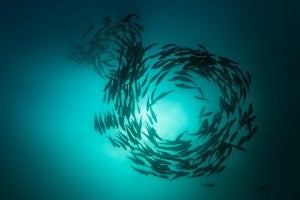
A spawning aggregation of the bigeye trevally, Caranx sexfasciatus, Cabo Pulmo National Park, Mexico.
Photo Credit: Octavio Aburto-Oropeza/Marine Photobank
“Unleashing the self-interest of local fishermen to advance both conservation and economic development can create one of those rare win-win scenarios.” This powerful quote from a recent op-ed, beautifully describes what is at the core of EDF’s mission to save fisheries.
The authors of that op-ed, Carl Safina, founding president of the Blue Ocean Institute at Stony Brook University, and Brett Jenks, chief executive of Rare, called attention to both the global depletion of fisheries AND the solution. They discuss how despite growing concern about the dire state of global fish populations, there is hope to rebuild them. “Why are we hopeful? They write, “It’s because the analysis of global fisheries has a silver lining. We have not reached a point of no return. We have time. Solutions exist.”
They draw from the first comprehensive analysis of more than 10,000 fisheries in the journal Science which finds that, “When sustainably managed, marine fisheries provide food and livelihoods for hundreds of millions of people worldwide.” Fisheries and food security for future generations are a challenge that we believe can be solved by partnering with fishermen to find common solutions, but we must act now.
The United States has made great progress in fisheries management. Almost two-thirds of fish landed in the United States are done so under a catch share. However, the United States is just one piece of the puzzle, Safina and Jenks point out that, “small-scale fishers — who fish within 10 miles of their coast — account for nearly half of the world’s global catch and employ 33 million of the world’s 36 million fishermen, while also creating jobs for 107 million people in fish processing and selling [pdf]. Mostly poor, they live mainly in areas lacking fisheries management, monitoring and enforcement.”
TURF reserves, or territorial use rights, are one solution that gives local, small scale fishermen exclusive access to the fishing grounds they depend on for food and economic livelihood. The fishermen agree to establish and enforce no-take zones which in turn replenish the fish populations, revitalize marine habitats and protect coastlines from effects of climate change. This model has potential to drive large scale change by empowering local fishermen to protect their own resource for the future. But the time is to act is now, and leveraging global change will require massive commitment from governments, foundations, NGOs and the private sector to jumpstart the implementation of thousands of TURF reserves in dozens of countries. The Global Partnership for Oceans, is one such initiative that brings together these entities to protect and restore the world’s oceans. Safina and Jenks write, “The coastal communities themselves must unfurl the ocean’s silver lining.” The solutions for change lie within those who rely on the ocean most.
Discussing and leveraging a global solution to the problem of decreased fish populations in an “increasingly hungry world” could not be more timely or relevant. Fish are the primary source of protein for an estimated one billion people around the world. As populations grow, dependence on seafood will also grow. We have an obligation to rebuild fish populations to help both people and the ocean for a sustainable future.









